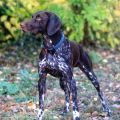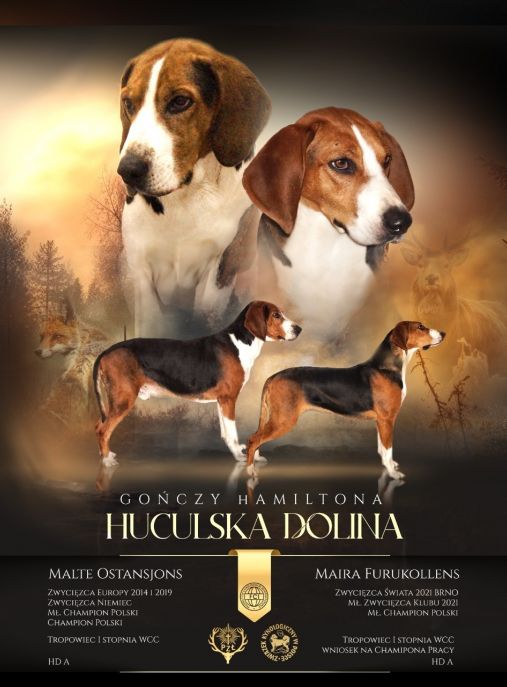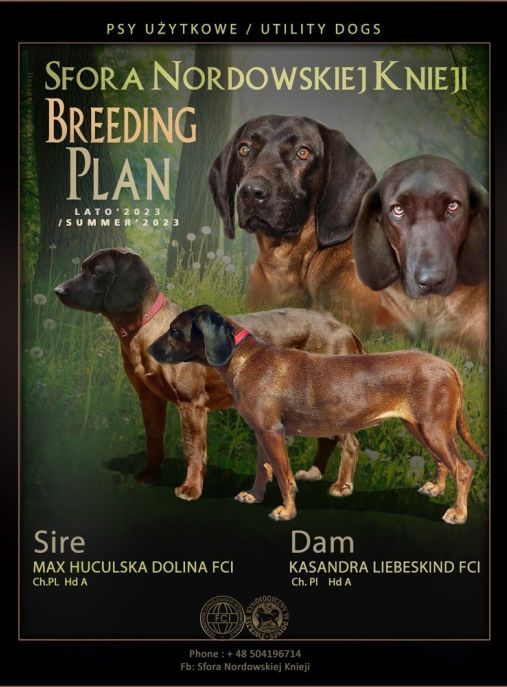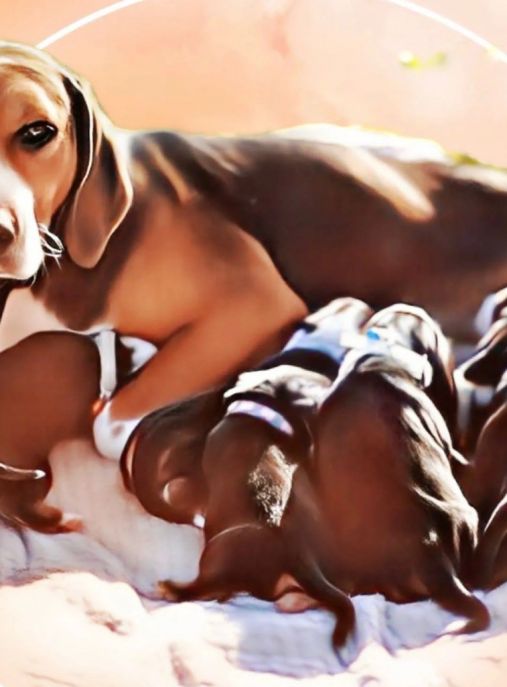The Hamiltonstövare, also known as the Hamilton Hound, is a remarkable dog breed that hails from Sweden. With its striking appearance and exceptional hunting abilities, this breed has gained popularity not only in its home country but also around the world. In this comprehensive text, we will delve into the history, characteristics, and other fascinating aspects of the Hamiltonstövare.
The Hamiltonstövare breed has a strong and muscular build, exuding power and agility. Their well-proportioned bodies are covered in a short, dense coat that comes in various color combinations, including black, tan, and white. Their expressive eyes, usually brown or hazel, are set apart and give them an alert and intelligent look. The ears are long and hang close to the head, enhancing their keen sense of hearing.
The history of the Hamiltonstövare dates back to the early 19th century when Count Adolf Hamilton, a Swedish nobleman and passionate hunter, began developing the breed. Count Hamilton aimed to create a versatile scent hound that could excel in tracking and hunting various game, including hare and fox. He achieved this by crossing several breeds, including the German Hound, Harrier, and English Foxhound.
According to the FCI (Fédération Cynologique Internationale) typology, the Hamiltonstövare belongs to Group 6: Scenthounds and Related Breeds. This group encompasses breeds that excel in tracking and trailing scents, often used for hunting purposes. The Hamiltonstövare is classified under Section 1.2: Medium-sized Hounds, alongside other notable breeds such as the Beagle and Basset Hound.
The Hamiltonstövare is primarily a hunting dog, known for its exceptional scenting abilities and determination in tracking game. They are particularly skilled in trailing scents on the ground, making them invaluable assets to hunters. However, their friendly and sociable nature also makes them wonderful family pets. They are known to be good with children and other animals, making them a versatile breed suitable for various households.
In terms of size, the Hamiltonstövare is considered a medium-sized breed. Males typically stand between 20.5 to 23.5 inches (52-60 cm) at the shoulder, while females are slightly smaller, ranging from 19.5 to 22.5 inches (50-57 cm). As for weight, males usually weigh between 55 to 66 pounds (25-30 kg), while females weigh slightly less, ranging from 49 to 60 pounds (22-27 kg).
The life expectancy of the Hamiltonstövare is around 12 to 14 years, which is relatively long for a medium-sized breed. This breed is generally healthy, with no major breed-specific health concerns. However, like all dogs, they may be prone to certain conditions such as hip dysplasia and ear infections. Regular exercise, a balanced diet, and routine veterinary care are essential to ensure their overall well-being.
One interesting fact about the Hamiltonstövare is their exceptional sense of smell. They possess a highly developed olfactory system, allowing them to detect scents with great precision. This makes them excellent tracking dogs, capable of following even the faintest scent trails. Additionally, their stamina and endurance enable them to cover long distances without tiring easily, making them ideal for hunting in various terrains.
Training the Hamiltonstövare requires patience and consistency. They are intelligent dogs but can be independent and stubborn at times. Early socialization and obedience training are crucial to ensure they grow into well-rounded and obedient companions. Positive reinforcement methods, such as rewards and praise, work best with this breed.
In conclusion, the Hamiltonstövare is a remarkable breed with a rich history and exceptional hunting abilities. Their striking appearance, friendly nature, and versatility make them a popular choice for both hunters and families alike. With proper care, training, and love, the Hamiltonstövare can bring joy and companionship to any household lucky enough to have them as a part of their lives.
The Hamiltonstövare, also known as the Hamilton Hound, is a remarkable breed of dog that possesses a unique character and temperament. Originating from Sweden, these dogs were initially bred for hunting purposes, specifically for tracking and trailing game. With their distinctive appearance and exceptional scenting abilities, Hamiltonstövare dogs have gained popularity not only as hunting companions but also as beloved family pets.
One of the most notable characteristics of the Hamiltonstövare is their friendly and sociable nature. They are known to be affectionate and loyal towards their owners, making them excellent companions for individuals and families alike. These dogs thrive on human interaction and enjoy being a part of family activities. They are generally good with children and other pets, although early socialization is crucial to ensure they develop proper manners and behavior.
Hamiltonstövare dogs are intelligent and eager to please, which makes them relatively easy to train. However, they can also be independent and stubborn at times, so consistent and patient training methods are necessary. Positive reinforcement techniques, such as treats and praise, work best with this breed. They respond well to structured training sessions that incorporate mental stimulation and physical exercise.
Due to their hunting background, Hamiltonstövare dogs have a strong prey drive and an exceptional sense of smell. This means they may have a tendency to chase small animals or become easily distracted by scents during walks. It is crucial to keep them on a leash or in a securely fenced area to prevent them from wandering off. Engaging them in activities that stimulate their natural instincts, such as scent games or tracking exercises, can help satisfy their hunting drive.
Exercise is an essential aspect of raising a Hamiltonstövare dog. They are an active breed that requires regular physical activity to keep them mentally and physically stimulated. Daily walks, jogs, or play sessions in a secure area are necessary to prevent boredom and potential destructive behavior. Providing them with puzzle toys or engaging in obedience training can also help channel their energy in a positive way.
Despite their active nature, Hamiltonstövare dogs are generally calm and well-mannered indoors. They can adapt well to apartment living as long as their exercise needs are met. However, they thrive in homes with access to a securely fenced yard where they can explore and play freely.
Grooming requirements for the Hamiltonstövare are relatively low. Their short, dense coat only requires occasional brushing to remove loose hair and maintain its shine. Regular ear cleaning and nail trimming are also necessary to prevent any potential issues.
In conclusion, the Hamiltonstövare is a friendly, intelligent, and active breed that makes an excellent companion for individuals or families. With proper training, socialization, and exercise, these dogs can thrive in various living environments. Their loyalty, affection, and exceptional scenting abilities make them not only great hunting partners but also cherished family pets.
The Hamiltonstövare, also known as the Hamilton Hound, is a beautiful and intelligent breed of dog that requires specific care to ensure their health and happiness. Here are some tips on how to care for Hamiltonstövare dogs, including what to do and what not to do:
1. Exercise: Hamiltonstövare dogs are active and energetic, so regular exercise is crucial. They require at least an hour of exercise daily, which can include walks, runs, or playtime in a secure, fenced area. Engaging them in mentally stimulating activities like puzzle toys or obedience training is also beneficial.
2. Mental Stimulation: These dogs are intelligent and have a strong sense of smell. Engage their minds by providing interactive toys, scent games, or even participating in tracking exercises. Mental stimulation helps prevent boredom and destructive behavior.
3. Grooming: Hamiltonstövare dogs have a short, dense coat that requires minimal grooming. Regular brushing with a soft bristle brush will help keep their coat clean and remove loose hair. Bathing should only be done when necessary, using a mild dog shampoo to avoid drying out their skin.
4. Health Care: Regular veterinary check-ups are essential to ensure your Hamiltonstövare's overall health. Vaccinations, parasite prevention, and dental care should be maintained according to your vet's recommendations. Regularly check their ears for signs of infection and trim their nails to prevent overgrowth.
5. Diet and Nutrition: Provide a balanced and nutritious diet suitable for your Hamiltonstövare's age, size, and activity level. High-quality dog food, preferably formulated for active breeds, is recommended. Avoid overfeeding to prevent obesity, as these dogs can be prone to weight gain.
6. Socialization: Hamiltonstövare dogs are social animals and thrive in the company of their family. Early socialization is crucial to ensure they grow up to be well-adjusted and friendly dogs. Expose them to various people, animals, and environments to help them develop good social skills.
7. Training: These dogs are intelligent and eager to please, making them relatively easy to train. Use positive reinforcement techniques like treats, praise, and rewards to motivate and encourage good behavior. Consistency and patience are key when training a Hamiltonstövare.
8. Avoid Overexertion: While Hamiltonstövare dogs are active, they can also be prone to certain health issues, such as hip dysplasia. Avoid excessive exercise, especially during their growth phase, to prevent joint problems. Provide them with appropriate rest and recovery time after intense activities.
9. Avoid Harsh Training Methods: Hamiltonstövare dogs respond best to positive reinforcement training methods. Avoid using harsh or punitive techniques as it can damage their trust and lead to behavioral issues. Be patient, consistent, and use rewards to reinforce desired behaviors.
10. Avoid Leaving Them Alone for Long Periods: Hamiltonstövare dogs thrive on human companionship and can suffer from separation anxiety if left alone for extended periods. If you have to be away, provide them with interactive toys, puzzle feeders, or consider hiring a dog walker or pet sitter to keep them company.
Remember, every dog is unique, and individual care requirements may vary. It's important to observe your Hamiltonstövare's behavior, monitor their health, and consult with a veterinarian for personalized advice. With proper care, love, and attention, your Hamiltonstövare will be a loyal and happy companion for years to come.
The Hamiltonstövare, also known as the Hamilton Hound, is a striking breed of dog that possesses a distinct and captivating coat color. The common color of Hamiltonstövare dogs is a rich and lustrous tricolor combination of black, tan, and white.
The primary color of the Hamiltonstövare's coat is black, which forms the base and provides a stunning contrast against the other colors. The black hue is deep and intense, giving the dog an air of elegance and sophistication. It covers most of the body, including the back, sides, and tail. The black coloration is solid and uniform, without any patches or variations.
Accompanying the black coat are tan markings that add warmth and depth to the overall appearance of the Hamiltonstövare. The tan color is usually found on the dog's face, legs, chest, and underside. It forms distinct patches or spots that are well-defined and evenly distributed. The tan markings are often seen above the eyes, on the cheeks, and on the lower part of the legs. These tan areas provide a beautiful contrast against the black background, creating a visually striking combination.
Completing the tricolor palette is the white color, which is typically found as a secondary color on the Hamiltonstövare. The white areas are usually seen on the chest, paws, and tip of the tail. These white patches are crisp and clean, standing out against the black and tan colors. The white coloration adds a touch of brightness and balance to the overall appearance of the dog.
The combination of black, tan, and white in the Hamiltonstövare's coat creates a harmonious and eye-catching color scheme. The contrast between the black and tan colors, along with the addition of white, gives the dog a distinctive and unique look. This tricolor coat is not only aesthetically pleasing but also serves a practical purpose, as it helps the Hamiltonstövare blend into various terrains during hunting activities.
It is important to note that while the tricolor combination is the most common color pattern for Hamiltonstövare dogs, there can be slight variations within the breed. Some individuals may have more extensive tan markings, while others may have smaller white patches. However, the overall tricolor scheme remains consistent, showcasing the breed's signature coloration.
In conclusion, the common color of Hamiltonstövare dogs is a captivating tricolor combination of black, tan, and white. This color scheme, with its deep black base, warm tan markings, and crisp white patches, creates a visually stunning coat that is both distinctive and beautiful. The Hamiltonstövare's coloration is a testament to the breed's elegance and charm, making them truly remarkable dogs to behold.
The Hamiltonstövare, also known as the Hamilton Hound, is a medium-sized breed of dog that originated in Sweden. These dogs are known for their exceptional hunting skills and their friendly and affectionate nature. When it comes to their health, Hamiltonstövare dogs are generally considered to be a healthy breed. However, like any other breed, they are prone to certain health issues that potential owners should be aware of.
One of the most common health problems seen in Hamiltonstövare dogs is hip dysplasia. This is a condition where the hip joint doesn't develop properly, leading to discomfort and mobility issues. Responsible breeders will perform hip evaluations on their breeding dogs to minimize the risk of passing on this condition. Regular exercise and maintaining a healthy weight can also help reduce the risk of hip dysplasia.
Another health concern in Hamiltonstövare dogs is hypothyroidism. This is a condition where the thyroid gland doesn't produce enough hormones, leading to a range of symptoms such as weight gain, lethargy, and skin issues. Regular blood tests can help diagnose and manage this condition, and affected dogs can be treated with hormone replacement therapy.
Like many other breeds, Hamiltonstövare dogs can also be prone to ear infections. Their long, droopy ears can trap moisture and debris, creating a perfect environment for bacteria and yeast to thrive. Regular ear cleaning and drying after swimming or bathing can help prevent infections. It's important to use a veterinarian-recommended ear cleaning solution and avoid inserting anything deep into the ear canal to prevent injury.
Additionally, Hamiltonstövare dogs may be susceptible to certain eye conditions such as progressive retinal atrophy (PRA) and cataracts. PRA is a degenerative condition that leads to gradual vision loss, while cataracts cause clouding of the lens, leading to impaired vision. Regular eye examinations by a veterinary ophthalmologist can help detect these conditions early on, allowing for appropriate management or treatment.
To ensure the overall health and well-being of Hamiltonstövare dogs, proper care and attention are essential. Regular veterinary check-ups are crucial to monitor their health, update vaccinations, and address any concerns promptly. A balanced and nutritious diet tailored to their specific needs is important to maintain optimal health and prevent obesity.
Exercise is also vital for Hamiltonstövare dogs. They have a strong hunting instinct and require regular physical and mental stimulation to stay happy and healthy. Daily walks, playtime, and opportunities to explore and sniff in a secure environment are recommended. However, it's important to avoid excessive exercise, especially in puppies, to prevent joint and bone issues.
Grooming requirements for Hamiltonstövare dogs are relatively low. Their short, dense coat only requires occasional brushing to remove loose hair and maintain a healthy shine. Regular dental care, including brushing their teeth and providing appropriate chew toys, can help prevent dental diseases.
In conclusion, Hamiltonstövare dogs are generally a healthy breed, but they can be prone to certain health issues such as hip dysplasia, hypothyroidism, ear infections, and eye conditions. Responsible breeding practices, regular veterinary care, a balanced diet, proper exercise, and good grooming habits are essential for maintaining the health and well-being of these wonderful dogs.
The Hamiltonstövare, also known as the Hamilton Hound, is a medium-sized breed of dog that originated in Sweden. These dogs are known for their hunting abilities and have a strong, muscular build. To ensure the health and well-being of Hamiltonstövare dogs, it is essential to provide them with a balanced and nutritious diet.
When it comes to feeding Hamiltonstövare dogs, it is important to consider their energy levels and activity levels. These dogs are highly active and require a diet that provides them with the necessary fuel to support their energy needs. A diet rich in high-quality proteins, healthy fats, and essential nutrients is crucial for their overall health.
Protein is an essential component of a Hamiltonstövare's diet as it helps in muscle development and repair. Good sources of protein for these dogs include lean meats like chicken, turkey, and fish. It is advisable to feed them a diet that consists of at least 25-30% protein.
In addition to protein, Hamiltonstövare dogs also require healthy fats in their diet. Fats provide them with a concentrated source of energy and help in maintaining healthy skin and coat. Including omega-3 fatty acids in their diet, such as those found in fish oil or flaxseed oil, can be beneficial for their overall health.
Carbohydrates are another important component of a Hamiltonstövare's diet. However, it is crucial to choose complex carbohydrates that provide sustained energy rather than simple carbohydrates that can cause spikes in blood sugar levels. Good sources of complex carbohydrates include whole grains, vegetables, and legumes.
When it comes to feeding Hamiltonstövare dogs, it is recommended to divide their daily food intake into two or three meals to avoid overeating and to aid in digestion. The portion size should be appropriate for their age, weight, and activity level. It is important to monitor their weight regularly and adjust the portion size accordingly to prevent obesity.
While providing a nutritious diet is essential, there are certain foods that should be avoided for Hamiltonstövare dogs. These include:
1. Foods high in fat: Excessive fat intake can lead to weight gain and digestive issues. Avoid feeding them fatty meats, fried foods, or excessive amounts of treats.
2. Foods high in sodium: Too much salt can be harmful to their health and may lead to dehydration or kidney problems. Avoid feeding them salty snacks or foods.
3. Foods toxic to dogs: Certain foods like chocolate, grapes, raisins, onions, garlic, and avocados can be toxic to dogs and should be strictly avoided.
4. Raw or undercooked meat: Raw or undercooked meat can contain harmful bacteria that can cause food poisoning. Always ensure that the meat is cooked thoroughly before feeding it to your Hamiltonstövare.
In addition to a balanced diet, it is important to provide fresh water at all times and to engage in regular exercise to keep your Hamiltonstövare healthy and fit. Regular visits to the veterinarian for check-ups and vaccinations are also crucial for their overall well-being.
Remember, every dog is unique, and their nutritional needs may vary. It is always recommended to consult with a veterinarian or a professional dog nutritionist to develop a personalized diet plan that suits your Hamiltonstövare's specific needs.







